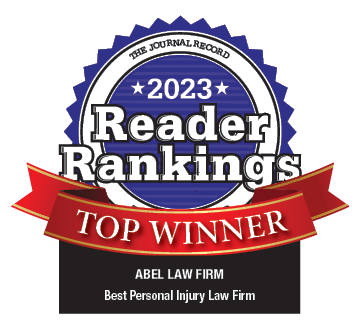A memorable way to describe the breadth of coverage of uninsured- or underinsured-motorist insurance (UM / UIM) is the scenario quoted by the Oklahoma Supreme Court from a Louisiana case: “‘There is no requirement in the statute that the insured have any relation, at the time of the accident, with any vehicle he owns and that is insured with the insurer. The uninsured motorist protection covers the insured and the family members while riding in uninsured vehicles, while riding in commercial vehicles, while pedestrians or while rocking on the front porch.’” Cothren v. Emasco, 1976 OK 137, 555 P.2d 1037, 1039 [quoting from Elledge v. Warren, 263 So.2d 912 (La.App.1972)].
Insurance companies may try to limit named insureds or members of their household to a covered auto or impose other restrictions, but such limitations are generally invalid and violate public policy.
UM Follows the Person
“… UM insurance is first-party coverage that follows the person.” Mustain v. United States Fidelity & Guaranty Co., 1996 OK 98, 925 P.2d 533, 535. The Oklahoma Legislature has mandated UM coverage for the protection of “… persons insured thereunder who are legally entitled to recover damages from owners or operators of uninsured motor vehicles and hit-and-run motor vehicles because of bodily injury, sickness or disease, including death resulting therefrom.” 36 O.S. §3636(C) (emphasis added).
“…[O]nce a person is insured under an uninsured motorist policy, subsequent exclusions inserted by the insurer in the policy which dilute and impermissively limit uninsured motorist coverage are void as violative of the public policy espoused by 36 O.S. … §3636.” State Farm Mutual Automobile Ins. Co. v. Wendt, 1985 OK 75, 708 P.2d 581, 583. The status of “insured” is determined by the definition in the policy. Shepard v. Farmers Ins. Co. Inc., 1983 OK 103, 678 P.2d 250, 252.
“Class 1” and “Class 2” Insureds
Class 1 insureds are the named insured and resident relatives in the named insured’s household; class 2 insureds (or “additional insureds”) are permissive users and occupants of an insured vehicle. See, Rogers v. Goad, 1987 OK 59, 739 P.2d 519, 521.
Class 1 insureds are entitled to the benefits of all policies for which separate premiums have been paid. Keel v. MFA Ins. Co., 1976 OK 86, 553 P.2d 153, 156 (allowing stacking of coverage by invalidating “other insurance” clause); Richardson v. Allstate Ins. Co., 1980 OK 157, 619 P.2d 594, 598 (coverage stackable when three separate premiums paid in single policy); Lake v. Wright, 1982 OK 98, 657 P.2d 643, 645 (coverage stackable and “our limit of liability clause” invalid when multiple premiums paid). “The underlying rationale … is to enforce the contractual expectations of the party purchasing the policies.” Rogers, 739 P.2d at 521.
“Class 2” Insureds
However, class 2 insureds are not specifically named in the policy, do not pay premiums and may not stack policies under which they are not insured. See, Babcock v. Adkins, 1984 OK 84, 695 P.2d 1340, 1343; Rogers, 739 P.2d at 521-522; Stanton v. American Mutual Liability Ins. Co., 1987 OK 118, 747 P.2d 945; Ball v. Wilshire Ins. Co., 2009 OK 38, 221 P.3d 717, 727. Babcock noted the trend among jurisdictions addressing the issue: “[O]ne who is a named insured under a policy or policies of uninsured motorist insurance possesses a broad reservoir of coverage by virtue of the fact that this coverage is not tied to the occupancy of any vehicle, while one whose status as an insured is tied to occupancy of an insured vehicle is entitled only to coverage under the specific policy covering that vehicle at the time of the accident.” Babcock, 695 P.2d at 1342.
Although class 2 insureds cannot take advantage of other policies owned by someone else, they are still “insureds” under the policy covering the vehicle they occupy and have a statutory and contractual relationship (as third-party beneficiaries) with the insurer. Townsend v. State Farm Mutual Automobile Ins. Co., 1993 OK 119, 860 P.2d 236, 238. The named insured “… purchased protection from uninsured motorists for himself, for family members, for permissive users, and for passengers.
This gave rise to a legitimate contractual expectation that the insurer would act in good faith and deal fairly with all insureds, whether they were of a class 1 or class 2.” Id. Class 2 insureds make a “first-party claim” against the UM carrier. Id. at 237, 238; see also, Claims Resolution Act, 36 O.S. §1250.2 (distinguishing first-party claimants who make a claim against an insurance policy and third-party claimants who make a claim against the person insured under the policy).
The 2004 Amendment to §3636
Because of a 2004 amendment to 36 O.S. §3636, class 1 insureds will not be covered under a UM policy if injured while occupying vehicles they own but fail to insure: “For purposes of this section, there is no coverage for any insured while occupying a motor vehicle owned by, or furnished or available for the regular use of the named insured, a resident spouse of the named insured, or a resident relative of the named insured, if such motor vehicle is not insured by a motor vehicle insurance policy.” 36 O.S. 2004 §3636(E).
It appears the Legislature was trying to ensure all vehicles will be covered by liability insurance pursuant to the Financial Responsibility Act, 47 O.S. §7-101 et seq. Insureds should not benefit from UM coverage on an insured vehicle while they are using an auto they haven’t bothered to insure. However, class 1 insureds have always been able to rely on the fact UM follows them to purchase UM on only one policy as long as all their vehicles have liability coverage. If they prefer, they may purchase UM on each vehicle in order to stack coverage.
Motor Vehicle Insurance Policies
The logical meaning of “motor vehicle insurance policy” in §3636(E) is a liability policy, not a UM policy. However, Division 3 of the Court of Civil Appeals has interpreted the amendment to mean the other policy must also include UM coverage. Conner v. American Commerce Ins., 2009 OK CIV APP 61, 216 P.3d 850, 851.
“Consistent with this public policy, §3636(E) does not allow a resident relative to avoid the protection of the public by not obtaining liability coverage on his vehicle while, at the same time, enjoying insurance protection through UM coverage on another vehicle. …” Id. That is clearly the purpose of the amendment, but the Conner court went further: “Defendant may preclude UM coverage from extending to Plaintiff’s motorcycle, which it does not insure and which is not otherwise covered for UM by any other insurer.” Id. (emphasis added).
The 2004 amendment also calls into question the prior case of Shepard v. Farmers, 678 P.2d at 252, which – giving effect to policy language — allowed a person who should have been a class 1 insured to be excluded from coverage simply because she owned a vehicle. The holding was based on a strained definition in the policy excluding anyone who owned a vehicle from the definition of “relative” of the insured. The 2004 amendment makes it clear she would have no UM coverage only if the vehicle she owned were uninsured. The definition in Shepard is inconsistent with the purpose of §3636(E).
Excluding Occupants who own their own Vehicles
Those who are not class 1 insureds have been excluded from UM coverage in employers’ policies based on the fact they are not the named insured and on the principle that vehicle owners must insure their own vehicles. Employees who are additional insureds for liability coverage while on the job (and who are not specifically named in the policy) may be eliminated as insureds under the UM portion of an employer’s policy when they are using their own automobiles. Graham v. Travelers Ins. Co., 2002 OK 95, 61 P.3d 225, 230 (validating an “owned autos only” designation). An employee of a school district injured while riding in district-owned vehicle was excluded as an insured for UM because he owned a car and had the opportunity to purchase his own UM coverage.
National American Ins. Co. v. Vallion, 2008 OK CIV APP 41, 183 P.3d 175, 179-180 (validating a limits of insurance clause, a definition of insured and an exclusion for those who owned cars). The minor son of a pharmacy owner was validly excluded from coverage under the pharmacy’s policy when riding a friend’s uninsured all-terrain vehicle. American Economy Ins. Co. v. Bogdahn, 2004 OK 9, 89 P.3d 1051, 1055 (finding unambiguous a definition of insured that would include family member only if named insured were an individual). On the other hand, a company policy may cover a specifically-named employee. See, Haberman v. The Hartford Insurance Group, 443 F.3d 1257, 1266 (10th Cir. [Okla.] 2006), in which the principal in a closely-held corporation riding in a vehicle owned by her employee was a named insured for UM purposes because of a “named person … as insured” endorsement.
Definition of “Insured” under Different Coverages
Insurance companies cannot re-define “insured” under the separate parts of a non-commercial policy. The court in Ameen v. Prudential Property and Casualty Ins. Co., 2005 OK CIV APP 23, 110 P.3d 86, 89, explained: “In Cothren …, the Oklahoma Supreme Court interpreted §3636 as forbidding exclusions of coverage that are inconsistent with the purpose and philosophy of mandatory uninsured motorist coverage.” The claimant in Ameen was injured while operating a motorcycle. The court found, “In the instant case, Insurer crafted the policy so as to redefine who was insured under the policy within each subdivision of coverage. Insurer argued Ameen was not an insured under the terms of the policy for the purposes of UM coverage if he was not in a car or on foot at the time of the accident.
However, such provisions violate §3636. The statute requires that an automobile liability policy provide UM coverage ‘for the protection of persons insured thereunder.’ Ameen is listed as a resident relative under the policy and his parents paid a premium for his coverage. The premium included surcharges and discounts based upon Ameen’s status. Therefore, Ameen is insured under his parents’ automobile liability policy and is entitled to UM benefits under the policy. … Insurer may not dilute the legislatively mandated UM coverage by restricting coverage based upon the particular vehicle the insured is occupying at the time of injury. The policy provisions purporting to do so violate the public policy of §3636.” Id. at 90.
Statutorily-Mandated Coverage
Oklahoma courts have carefully preserved the “clearly expressed legislative intent” of the UM statute and examined policy provisions “with critical scrutiny”. Wendt, 708 P.2d at 583. As a result, as long as class 1 insureds are not in a vehicle they failed to insure for liability coverage, UM should follow them everywhere – even as they relax in their favorite rocking chairs.
–Lynn Brusin Mares


